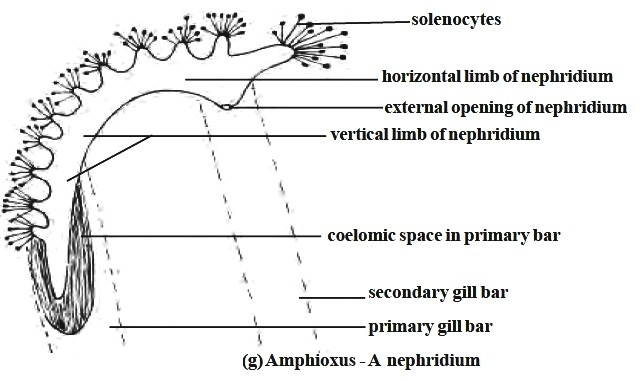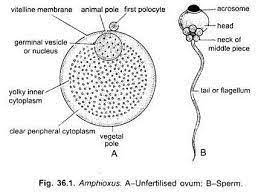In Branchiostoma primary excretion occur through nephridia, the nephridia in Branchiostoma is ectodermal in origin. In higher Chordate primary excretory organ is kidneys and it is mesodermal origin but in the case of Branchiostoma, it is ectodermal.
Table of Contents
Protonephridia:
On the dorsolateral wall of the pharyngeal region around 100 protonephridia are present on either side of the body. On the pharyngeal wall above each gill slits, sac-like ciliated tubular protonephridia are present, protonephridia are ectodermal in origin. Each protonephridium has an H shape with a short posterior horizontal limb and lower vertical limb.
The vertical limb is closed on the terminal end while the horizontal limb opens into the atrium through an aperture known as nephridiopore. The dorsal surface of protonephridia has several branches and each branch is connected to the tuft of flame cells or solenocytes. In protonephridia around 500 solenocytes or flame cells.
Each solenocyte has a terminal rounded knob-like nucleated cell body and a stalk-like hollow tubular part. The solenocytes are connected to the branch of the nephridia via the stalk-like part of protonephridia. The cell body of each solenocyte has a basal body, from the basal body a long flagellum that passes through the lumen of the hollow tubular stalk of the solenocytes which also extends inside the lumen of the branch of protonephridium.

The free end of all solenocytes remain in the blood and coelomic fluid, the nitrogenous waste materials extracted from the coelomic fluid and blood and the extracted excretory material goes inside the lumen of protonephridia. From the lumen of protonephridia, the nitrogenous waste materials go into the atrial cavity through the nephridiopore.
Brown Funnel:
In Branchiostoma two sac-like brown funnels are present on either side of the body dorsally. Anterior narrow tubules of brown funnel open into the dorsal coelomic canal and the broad posterior region of the brown funnel open into the atrial cavity. Most workers assumed that the brown funnel takes part in excretion but some workers think that it acts as a sensory organ.
Renal Papillae:
In the atrial cavity, some group of cells presents on the floor of the atrium known as renal papillae, and most of the workers considered them as an excretory organ.
Some cells present in the atrial wall take part in excretion, the yellow masses found in testes in Branchiostoma are also responsible for the excretion of nitrogenous waste materials. During the release of gametes, testes release the yellow masses which has uric acid and this process excrete the nitrogenous waste materials in the form of yellow masses
Reproductive System of Branchiostoma:
Branchiostoma generally reproduces through the sexual mode of reproduction, males and females are separate. But male and female Branchiostoma are identical on external appearance so sexual dimorphism is absent in Branchiostoma.
Gonads:
In Branchiostoma males and females have similar gonads arranged in two rows, a total number of gonads in adult individuals is around 25 pairs. Along the two ventrolateral sides, from the mid part of the pharynx to the atriopore gonads are arranged in longitudinal rows. The sac-like gonads are visible from outside through their transparent body wall.

Gonads are covered by atrial epithelium on the inner side, on outside the gonad are surrounded by a secondary gonidial cavity. Inside the secondary gonidial cavity or gonocoel, another cavity is presently known as the primary gonodial cavity, primary gonodial cavity surrounds germ cells which originates from the wall of the primary gonodial cavity.
Gametes:
In Branchiostoma sexual dimorphism is absent, even gonads are similar in males and females from outside. But the section of gonads helps us to separate testes and ovary, in mature testes presence of spermatozoa and in nature ovary presence of ova difference testes and ovary.
Branchiostoma has the record of smallest sperm in Chordata, sperm cells have a nucleated head with an acrosome cap, a middle piece, and a long tail. The mature egg is rounded with a large prominent nucleus and very less amount of yolk, the egg is microlecithal.

The gametes are released into the atrial cavity through the gonodial aperture present on the wall of gonads and the gametes go outside through the atriopore. The sperm and ova fuse in the seawater and the zygote finally form the embryo, the development of the young embryo occurs in the seawater externally.
Reference
Detailed Information on
Characteristics Features of Subphylum Urochordata
Classification of Subphylum Urochordata
Examples of Subphylum Urochordata: Clavellina, Salpa, and Doliolum
Examples of Subphylum Urochordata
Branchiostoma Habitat and Geographical Distribution
External Morphology of Branchiostoma
Body Wall and Endoskeleton of Branchiostoma
Coelom and Movement in Branchiostoma
Digestive System of Branchiostoma
Hi Everyone!!! Welcome to Imaluop. Imaluop always try to learn some new and he want to share to other people. Here we will try to learn various topics on Science, specially on Biological Sciences.